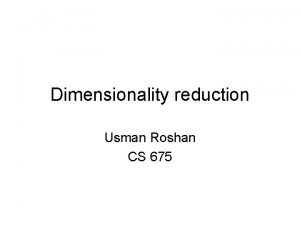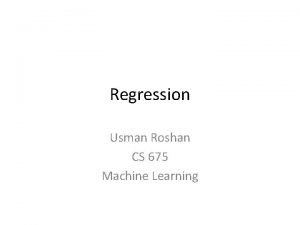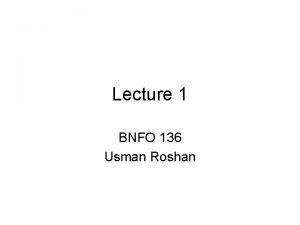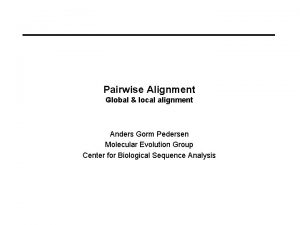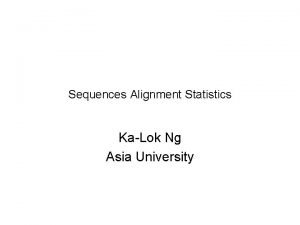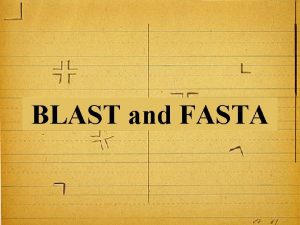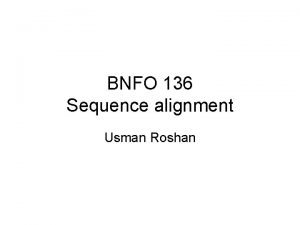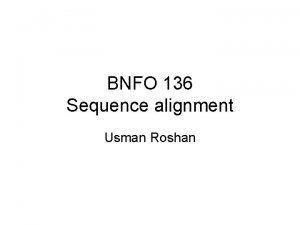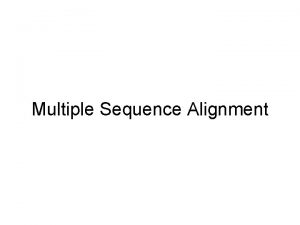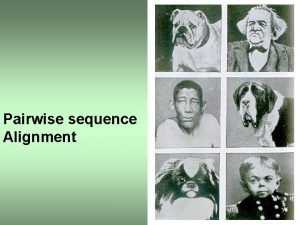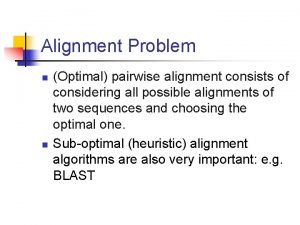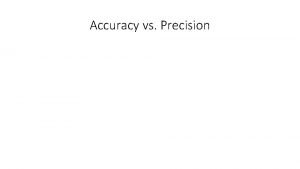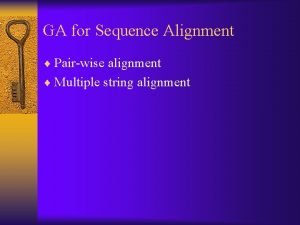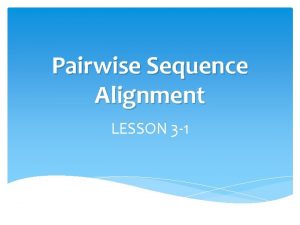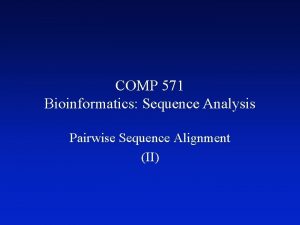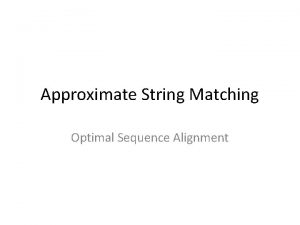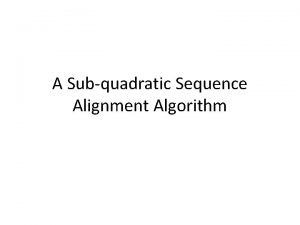Expected accuracy sequence alignment Usman Roshan Optimal pairwise





















- Slides: 21

Expected accuracy sequence alignment Usman Roshan

Optimal pairwise alignment • Sum of pairs (SP) optimization: find the alignment of two sequences that maximizes the similarity score given an arbitrary cost matrix. We can find the optimal alignment in O(mn) time and space using the Needleman-Wunsch algorithm. • Recursion: Traceback: where M(i, j) is the score of the optimal alignment of x 1. . i and y 1. . j, s(xi, yj) is a substitution scoring matrix, and g is the gap penalty

Affine gap penalties • Affine gap model allows for long insertions in distant proteins by charging a lower penalty for extension gaps. We define g as the gap open penalty (first gap) and e as the gap extension penalty (additional gaps) • Alignment: – ACACCCT – AC-CT-T – Score = 0 ACACCCC AC--CTT Score = 0. 9 • Trivial cost matrix: match=+1, mismatch=0, gapopen= -2, gapextension=-0. 1

Affine penalty recursion M(i, j) denotes alignments of x 1. . i and y 1. . j ending with a match/mismatch. E(i, j) denotes alignments of x 1. . i and y 1. . j such that yj is paired with a gap. F(i, j) defined similarly. Recursion takes O(mn) time where m and n are lengths of x and y respectively.

Expected accuracy alignment • The dynamic programming formulation allows us to find the optimal alignment defined by a scoring matrix and gap penalties. This may not necessarily be the most “accurate” or biologically informative. • We now look at a different formulation of alignment that allows us to compute the most accurate one instead of the optimal one.

Posterior probability of xi aligned to yj • Let A be the set of all alignments of sequences x and y, and define P(a|x, y) to be the probability that alignment a (of x and y) is the true alignment a*. • We define the posterior probability of the ith residue of x (xi) aligning to the jth residue of y (yj) in the true alignment (a*) of x and y as Do et. al. , Genome Research, 2005

Expected accuracy of alignment • We can define the expected accuracy of an alignment a as Do et. al. , Genome Research, 2005 • The maximum expected accuracy alignment can be obtained by the same dynamic programming algorithm

Example for expected accuracy • • True alignment AC_CG ACCCA Expected accuracy=(1+1+0+1+1)/4=1 • • Estimated alignment ACC_G ACCCA Expected accuracy=(1+1+0. 1+0+1)/4 ~ 0. 75

Estimating posterior probabilities • If correct posterior probabilities can be computed then we can compute the correct alignment. Now it remains to estimate these probabilities from the data • PROBCONS (Do et. al. , Genome Research 2006): estimate probabilities from pairwise HMMs using forward and backward recursions (as defined in Durbin et. al. 1998) • Probalign (Roshan and Livesay, Bioinformatics 2006): estimate probabilities using partition function dynamic programming matrices

HMM posterior probabilities • Consider the probability of all alignments of sequences X and Y under a given HMM. • Let M(i, j) be the sum of the probabilities of all alignments of X 1. . . i and Y 1…j that end in match or mismatch. • Then M(i, j) is given by • We calculate X(i, j) and Y(i, j) in the same way. • We call these forward probabilities: – f(i, j) = M(i, j)+X(i, j)+Y(i, j)

HMM posterior probabilities • Similarly we can calculate backward probabilties M’(i, j). • Define M’(i, j) as the sum of probabilities of all alignments of Xi. . m and Yj. . n such that Xi and Yj are aligned to each other. • The indices i and j start from m and n respectively and decrease • These are also called backward probabilities. – B(i, j)=M’(i, j)+X’(i, j)+Y’(i, j)

HMM posterior probabilities • The posterior probability of xi aligned to yj is given by

Partition function posterior probabilities • Standard alignment score: • Probability of alignment (Miyazawa, Prot. Eng. 1995) • If we knew the alignment partition function then

Partition function posterior probabilities • Alignment partition function (Miyazawa, Prot. Eng. 1995) • Subsequently

Partition function posterior probabilities • More generally the forward partition function matrices are calculated as

Partition function matrices vs. standard affine recursions

Posterior probability calculation • If we defined Z’ as the “backward” partition function matrices then

Posterior probabilities using alignment ensembles • By generating an ensemble A(n, x, y) of n alignments of x and y we can estimate P(xi~yj) by counting the number of times xi is aligned to yj. . Note that this means we are assigning equal weights to all alignments in the ensemble.

Generating ensemble of alignments • We can use stochastic backtracking (Muckstein et. al. , Bioinformatics, 2002) to generate a given number of optimal and suboptimal alignments. • At every step in the traceback we assign a probability to each of the three possible positions. • This allows us to “sample” alignments from their partition function probability distribution. • Posteror probabilities turn out to be the same when calculated using forward and backward partition function matrices.

Probalign 1. For each pair of sequences (x, y) in the input set – a. Compute partition function matrices Z(T) – b. Estimate posterior probability matrix P(xi ~ yj) for (x, y) by • Perform the probabilistic consistency transformation and compute a maximal expected accuracy multiple alignment: align sequence profiles along a guide-tree and follow by iterative refinement (Do et. al. ).

Experimental results • http: //bioinformatics. oxfordjournals. org/c ontent/26/16/1958
 Usman roshan
Usman roshan Luxborg
Luxborg Usman roshan
Usman roshan Usman roshan
Usman roshan Usman roshan
Usman roshan Usman roshan
Usman roshan Usman roshan
Usman roshan Yann le cunn
Yann le cunn Pairwise alignment
Pairwise alignment Ebi pairwise alignment
Ebi pairwise alignment Pairwise alignment
Pairwise alignment Pairwise alignment
Pairwise alignment Difference between blast and fasta
Difference between blast and fasta Global alignment vs local alignment
Global alignment vs local alignment Global alignment
Global alignment Sequence alignment
Sequence alignment Global alignment vs local alignment
Global alignment vs local alignment Global alignment
Global alignment Roshan dalvi
Roshan dalvi Rohana roshan
Rohana roshan Roshan chitrakar
Roshan chitrakar Roshan dalvi
Roshan dalvi
